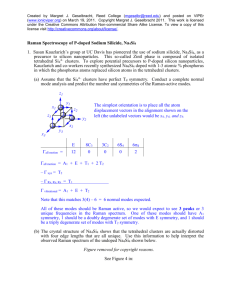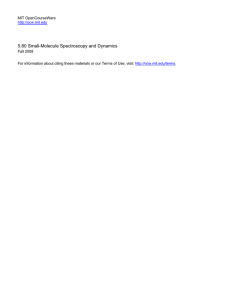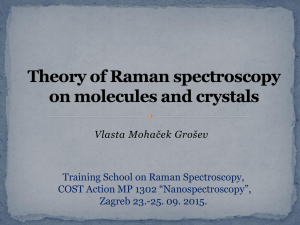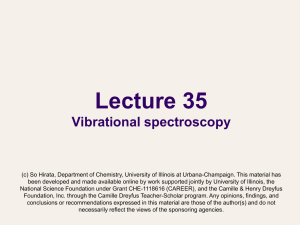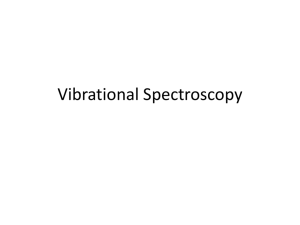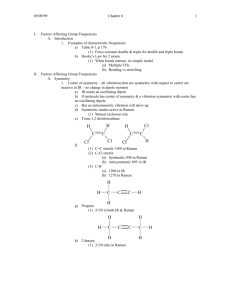Advanced Inorganic Spectroscopy
advertisement
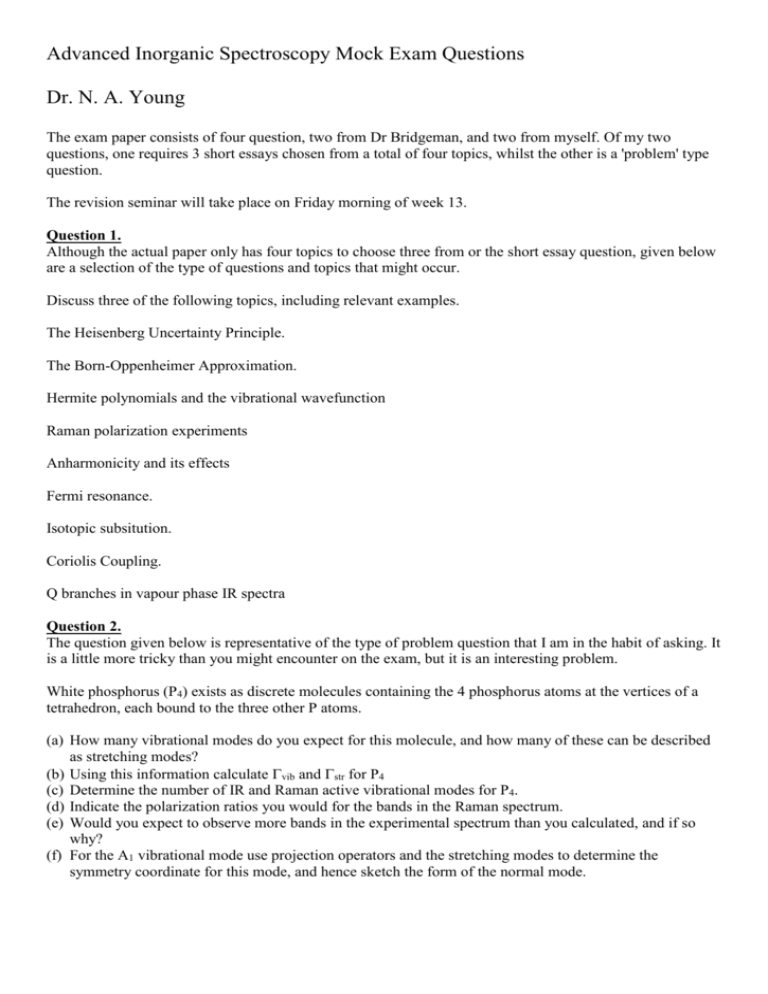
Advanced Inorganic Spectroscopy Mock Exam Questions Dr. N. A. Young The exam paper consists of four question, two from Dr Bridgeman, and two from myself. Of my two questions, one requires 3 short essays chosen from a total of four topics, whilst the other is a 'problem' type question. The revision seminar will take place on Friday morning of week 13. Question 1. Although the actual paper only has four topics to choose three from or the short essay question, given below are a selection of the type of questions and topics that might occur. Discuss three of the following topics, including relevant examples. The Heisenberg Uncertainty Principle. The Born-Oppenheimer Approximation. Hermite polynomials and the vibrational wavefunction Raman polarization experiments Anharmonicity and its effects Fermi resonance. Isotopic subsitution. Coriolis Coupling. Q branches in vapour phase IR spectra Question 2. The question given below is representative of the type of problem question that I am in the habit of asking. It is a little more tricky than you might encounter on the exam, but it is an interesting problem. White phosphorus (P4) exists as discrete molecules containing the 4 phosphorus atoms at the vertices of a tetrahedron, each bound to the three other P atoms. (a) How many vibrational modes do you expect for this molecule, and how many of these can be described as stretching modes? (b) Using this information calculate vib and str for P4 (c) Determine the number of IR and Raman active vibrational modes for P4. (d) Indicate the polarization ratios you would for the bands in the Raman spectrum. (e) Would you expect to observe more bands in the experimental spectrum than you calculated, and if so why? (f) For the A1 vibrational mode use projection operators and the stretching modes to determine the symmetry coordinate for this mode, and hence sketch the form of the normal mode. For more practice at Group Theory type questions I have included below some from the old symmetry course that you have probably seen before. Whilst not as detailed as the 4th year questions, they will give you practice. In square brackets are exercises more related to the 4th year course. 1996 Symmetry Paper When RuCl3 is reacted with a mixture of HCl, HCOOH (formic acid) and CsCl a yellow precipitate is formed. Analysis of the precipitate gave 23.8% Ru, 31.3% Cs and 25.1% Cl. The mass spectrum of the mono-anion gave a cluster of peaks at 292m/z, with three successive losses of 28. Using the C-O region of the IR and Raman spectra, show how Group Theory could be used to determine the shapes of the isomers formed. Indicate which you think is most likely. Show all your workings. 1997 Symmetry Paper Show how vibrational spectroscopy (use only the Xe-F stretching modes) and Group Theory can be used to differentiate between the two isomers of [XeF3]+ shown below. Which of these is the most likely and why? + + F F Xe F F Xe F F D3h C2v [You could also calculate vib and the symmetry coordinates for the stretching modes for both of these isomers. What kind of isotope patterns would you expect if the F was replaced by Cl?] 1998 Symmetry Paper Caesium perchlorate is thought to exist in the vapour phase as a molecular species with either tridentate or bidentate coordination of the caesium. Show how a combination of Group Theory and vibrational spectroscopy (consider the Cl-O stretching modes only) could be used to differentiate between these two isomers. O Cl O O O O Cl O Cs C3v [You could calculating vib] C2v O O Cs 1999 Symmetry Paper (i) (ii) (iii) (iv) (v) Using Group Theory determine str for the two isomers of VF5 shown below. Which of these irreducible representations are IR and/or Raman active? How many IR and Raman bands will be observed for each isomer? How many of the Raman bands will be polarised? The gas phase IR spectrum of VF5 had bands in the V-F stretching region at 810 and 784 cm-1, whereas the Raman spectrum had bands at 810, 719 and 608 cm-1, the last two being polarised. Using this information, identify the molecular shape of VF5. F F V F F F F D3h V F F F F C4v [For extra practice work out vib for both, and the symmetry coordinates for the D3h isomer.]

